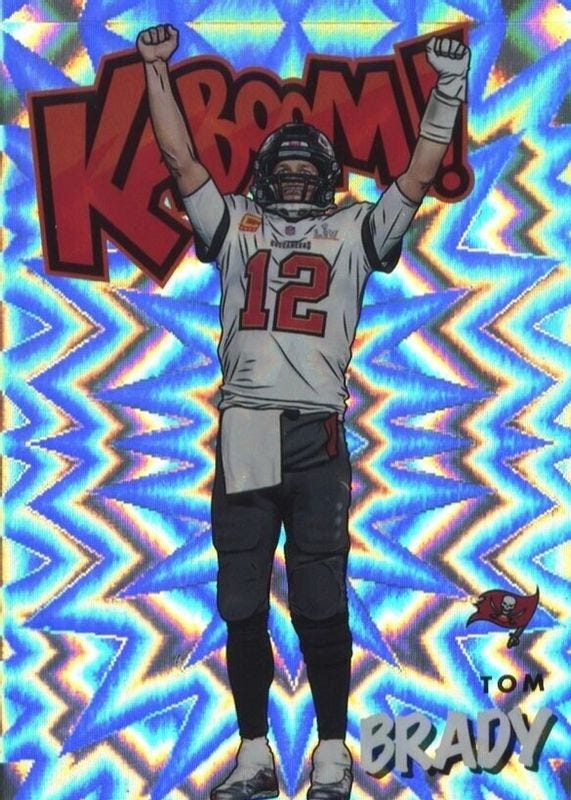Walk through any major card show in North America, and you’ll hear it.
"Any Kabooms?"
In just over a decade, Panini’s Kaboom! inserts have gone from niche experiment to the most coveted chase cards in modern sports collecting. They don’t have autographs. They don’t have jersey patches. They weren’t the centerpiece of any product. And yet, they’ve disrupted the hierarchy of what collectors value—and redefined what a modern grail can be.
This is the story of how a comic book-inspired sketch turned into a six-figure collectible and shifted the landscape of the sports card hobby.
From Gimmick to Gold Standard
Kaboom! launched in 2013 as part of Panini’s short-lived Innovation Basketball line. At the time, the hobby was dominated by autographs, relics, and high-end products like National Treasures. Inserts were often filler. But Panini wanted to try something different.
Instead of another photo card, they gave Hungarian illustrator Gyula Nemeth free rein to create something with energy. The result was a stylized rendering of Kobe Bryant, mid-dunk, bursting from a comic book explosion. No arena. No crowd. Just raw motion and ink.
Internally, there were doubts. Was it too gimmicky? Too cartoonish?
Collectors didn’t think so. The original 2013 Kaboom! cards were an instant hit. The set was discontinued after two years—but Kaboom! survived, moving into Panini’s Crown Royale and Absolute Football products, eventually expanding across sports like soccer, UFC, and WWE.
It went from experiment to anchor.
Why Kaboom! Works
What makes Kaboom! different from everything else?
Aesthetic: Kaboom! cards look like pages from a Marvel or DC comic book. They’re dynamic, hand-drawn, and instantly recognizable.
Foil Finish: The sparkly, refractive foil background gives each card visual impact from across a room.
No Autos, No Relics: Its value is derived purely from rarity, visual design, and player selection—not a sticker autograph or game-worn jersey.
Scarcity: Kaboom! cards are typically super short prints (SSPs)—usually one per sealed case, sometimes less.
Cross-Sport Appeal: Kaboom! didn’t stay in basketball. It now spans NFL, soccer, UFC, WWE, and more—creating a multi-sport ecosystem of collectors chasing the same insert.
Kaboom! helped prove what was previously unthinkable in modern collecting: a card could become a grail without ink, memorabilia, or serial numbering. The art—and the chase—was enough.
The Kaboom! Effect
Kaboom! didn’t just succeed—it reshaped the modern insert market.
It paved the way for other Panini-designed hits like Downtown, Color Blast, and Night Moves, each borrowing elements from Kaboom!’s formula: unique art direction, SSP status, and no autographs. But none have matched Kaboom!’s mix of visual impact and collector demand.
It also forced collectors and graders to recalibrate. Suddenly, design-driven inserts were fetching more on the secondary market than sticker-autographed rookies of mid-tier players. High-grade Kabooms of elite athletes became trophies.
The Numbers Behind the Hype
Kaboom! cards now routinely sell for five—and sometimes six—figures:
A Giannis Antetokounmpo 1/1 Green Kaboom! (2018-19) sold for $97,200
A Justin Herbert Green Rookie 1/1 (2020) hit $79,200
A Gold Tom Brady (#/10, 2021 Absolute) reached $33,200
A 2013 Kobe Bryant PSA 10 Kaboom! fetched $22,325
And yet, Kaboom! cards are notoriously tough to grade. According to PSA data, only 36% of Kaboom! submissions have earned a Gem Mint 10, compared to 53% for Downtown and 55% for Color Blast. The thick cardstock and foil finish make them vulnerable to print lines and edge wear—making high-grade copies even more desirable.
What Most Collectors Don’t Know
Kaboom! was almost killed early. The Innovation set that launched it was discontinued, and Kaboom! barely survived.
Designs vary year-to-year. While the core aesthetic remains, the Kaboom! design has evolved across different products and sports.
Grading is a minefield. Even freshly pulled cards often come with surface issues or printing defects.
Base Kabooms can outsell autographs. A base Kaboom! of a superstar can outprice an autograph of a less popular player—a major inversion from the autograph-first era of the 2000s.
The branding is genius. The word "Kaboom!" in comic-style font is now synonymous with chase cards. Collectors can spot it from across a card show.
The Takeaway
Kaboom! is more than a flashy card. It’s a case study in how bold design, scarcity, and branding can disrupt an entire ecosystem. It has no ink, no memorabilia, and no right to be this important—except that it is.
It’s the card that changed the rules.
And whether you collect modern rookies, invest in short prints, or just appreciate great design, one thing is clear: Kaboom! isn’t a fad. It’s the blueprint.
When someone yells “Kaboom!” at your next card show, pay attention. You’re not just witnessing hype.
You’re witnessing a revolution in cardboard.




I'm still waiting on my first KABOOM!